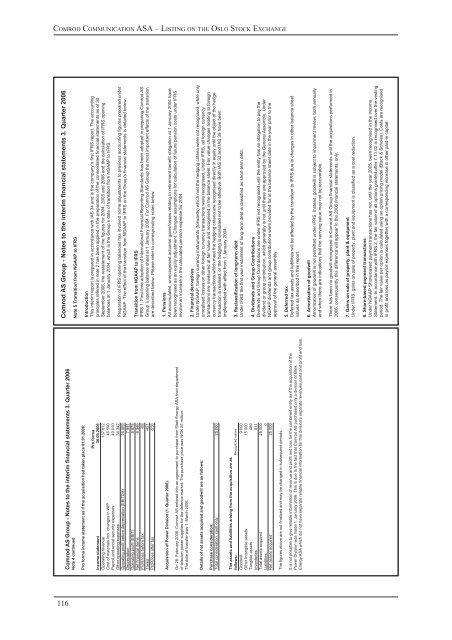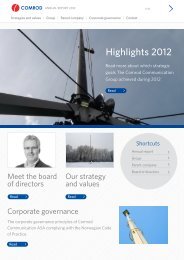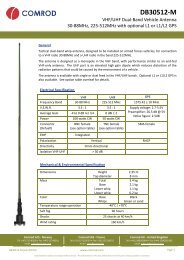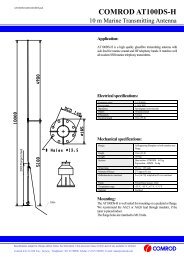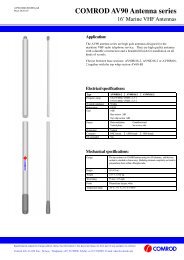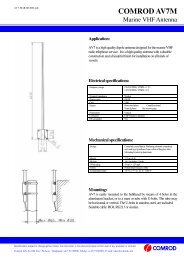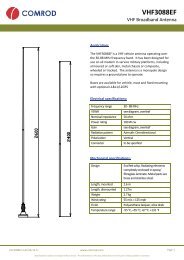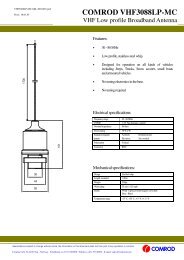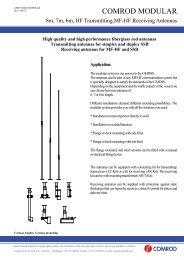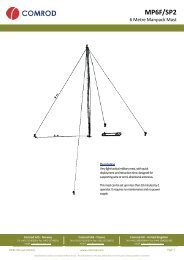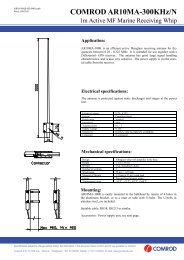English version - Hexagon Composites ASA
English version - Hexagon Composites ASA
English version - Hexagon Composites ASA
You also want an ePaper? Increase the reach of your titles
YUMPU automatically turns print PDFs into web optimized ePapers that Google loves.
COMROD COMMUNICATION <strong>ASA</strong> – LISTING ON THE OSLO STOCK EXCHANGE<br />
Comrod AS Group - Notes to the interim financial statements 3. Quarter 2006<br />
Note 4 continued<br />
Pro forma income statement as if the acquisition had taken place 01.01.2006:<br />
Pro forma<br />
Income statement 30.09.2006<br />
Operating revenue 137 812<br />
Cost of materials incl. changes in WIP 46 590<br />
Payroll and social security expenses 40 010<br />
Other operating expenses 34 342<br />
Operating profit before depreciation (EBITDA) 16 869<br />
Depreciation 7 991<br />
Operating profit (EBIT) 8 878<br />
Net financial items -8 946<br />
Profit/loss before tax -68<br />
Taxes -491<br />
Profit/loss after tax -558<br />
Acquisition of Power Division (1. Quarter 2006).<br />
On 28. February 2006, Comrod AS entered into an agreement to purchase from Eltek Energy <strong>ASA</strong> their department<br />
of telecom power supplies for the defence market. The purchase price was NOK 25 million.<br />
The date of transfer was 1. March 2006.<br />
Details of net assets acquired and goodwill are as follows:<br />
Purchase consideration:<br />
Total consideration, cash only 25 000<br />
The assets and liabilities arising from the acquisition are as<br />
follows:<br />
Recognized values<br />
Goodwill 9 000<br />
Other Intangible assets 15 000<br />
Tangible assets 489<br />
Inventories 511<br />
Total assets acquired 25 000<br />
Liabilities 0<br />
Net assets acquired 25 000<br />
The figures above are not finalized and may be changed in subsequent periods.<br />
It is not possible to give reliable information of revenue and profit and loss for the combined entity as if the acquisition of the<br />
Power Division was made 1. January 2006. This is due to the fact that Comrod AS purchased only a division of Eltek<br />
Energy <strong>ASA</strong> which did not have separate reliable financial information for this division’s separate revenues,costs and profit and loss.<br />
Comrod AS Group - Notes to the interim financial statements 3. Quarter 2006<br />
Note 5 Transition from NGAAP to IFRS<br />
Introduction<br />
This interim report is prepared in accordance with IAS 34 and is the company´s first IFRS report. The accounting<br />
principles refered in note 2 has been applied in the preparation of the consolidated financial statements as of 30<br />
September 2006, the restatement of the figures for 2004, 2005 and 2006 and the calculation of IFRS opening<br />
balances at 1 January 2004, which is the Group’s date of transition from NGAAP to IFRS.<br />
Preparation of IFRS opening balances has involved some adjustments to previous accounting figures prepared under<br />
NGAAP. The effect of the transition from NGAAP to IFRS on the Group’s financial statements is detailed below.<br />
Transition from NGAAP to IFRS<br />
IFRS 1, First-time adoption of International Financial Reporting Standards has been adopted in preparing Comrod AS<br />
Group´s opening balance sheet at 1 January 2004. For Comrod AS Group the most important effects of the transition<br />
are described below. Please refer to corresponding notes below.<br />
1. Pensions<br />
All accumulated, unrecognised actuarial gains/losses relating to retirement benefit obligation at 1 January 2004 have<br />
been recognised as an equity adjustment. Changed assumptions for calculation of future pension costs under IFRS<br />
involve an increase in the calculated pension expense for 2004.<br />
2. Financial derivatives<br />
Under NGAAP, foreign currency instruments (forwards) which met the hedging criteria were not recognised, while only<br />
unrealised losses on other foreign currency transactions were recognised. Under IFRS, all foreign currency<br />
transactions are measured at fair value and recognised in the balance sheet. Fair value changes relating to foreign<br />
currency transactions which meet the hedging criteria are recognised directly in equity until the object of the hedge<br />
transaction is realised, or the hedging is evaluated not to be effective. Both IAS 32 and IAS 39 have been<br />
implemented with effect from 1 January 2004.<br />
3. Reclassification of long-term debt<br />
Under IFRS the first year instalment of long-term debt is classified as short-term debt.<br />
4. Dividends and Group Contributions<br />
Dividends and Group Contributions are under IFRS not recognised until the entity has an obligation to pay the<br />
dividend or group contribution, which generally is not until these are approved by the General Assembly. Under<br />
NGAAP dividends and group contributions were provided for at the balance sheet date in the year prior to the<br />
approval of the general assembly.<br />
5. Deferred tax<br />
Deferred tax assets and liabilities will be affected by the transition to IFRS due to changes in other balance sheet<br />
values as described in this report.<br />
6. Amortization of goodwill<br />
Amortization of goodwill is not permitted under IFRS. Instead, goodwill is subject to impairment review, both annually<br />
and when there are indications that the carrying value may not be recoverable.<br />
There has been no goodwill recognised in Comrod AS Group financial statements until the acquisitions performed in<br />
2006, consequently this difference will appear in the 2006 financial statements, only.<br />
7. Gains on sale of property, plant & equipment<br />
Under IFRS, gains on sale of property, plant and equipment is classified as a cost reduction.<br />
8. Share-based payment transactions<br />
Under NGAAP Share-based payment transactions has not, until the year 2005, been recognised in the Income<br />
Statement. In accordance with IFRS 2, the fair value of all options granted after 7.11.02 is recognised over the vesting<br />
period. The fair value per option is calculated using an option pricing model (Black & Scholes). Costs are recognised<br />
in profit and loss as payroll expenses together with a corresponding increase in other paid-in capital.<br />
116


